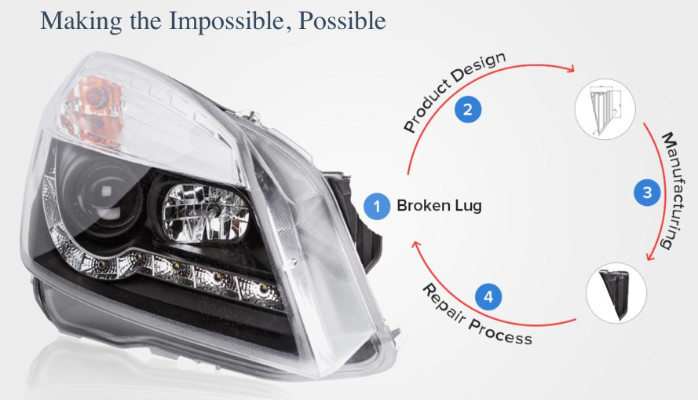The automotive industry is rapidly evolving, especially regarding materials used in vehicle manufacturing. Innovations in light composites, carbon fiber, biodegradable polymers, and the expanded use of polypropylene are transforming how vehicles are made, offering significant benefits in weight reduction, strength, sustainability, and cost-effectiveness. These advancements not only enhance vehicle performance but also impact the collision repair sector by necessitating the development of new tools, materials, and training to handle and repair these innovative materials. Innovation and technology are also playing a role in 3D printing, allowing for new advanced materials such as plastics and metals to be used in the 3D printing of parts that OEMs are starting to adopt in their manufacturing process.
Light Composites: Enhancing Strength and Reducing Weight
Advanced Plastics
Advanced plastics have expanded the possibilities in automotive manufacturing due to their high performance in withstanding temperatures and mechanical stresses. These plastics are now used in a wide range of automotive components, from under-the-hood parts to interior fixtures.
Benefits of Advanced Plastics:
- Weight Reduction: Lighter materials improve fuel efficiency and reduce emissions.
- Cost-Effectiveness: Generally less expensive than metals, reducing manufacturing costs.
- Durability and Performance: Enhanced properties allow plastics to replace heavier materials without compromising performance.
Polypropylene: Expanded Use and Environmental Implications
Polypropylene, once primarily used for bumper covers, is now increasingly utilized in most external body parts and trims due to its cost-effectiveness, durability, and flexibility. However, this rise in usage has led to a significant increase in plastic waste, presenting both challenges and opportunities for the collision repair industry.
Advantages of Polypropylene:
- Versatility: Suitable for various external body parts and trims.
- Cost-Effective: Less expensive than many other materials.
- Durability: Resistant to impact and environmental factors.
Environmental Implications:
- Plastic Waste: The increased use of polypropylene in vehicles has resulted in more plastic waste ending up in landfills.
- Repair Opportunities: The prevalence of polypropylene parts opens up new opportunities for repair rather than replacement, reducing waste and promoting sustainability.
Carbon Fiber
Carbon fiber is known for its exceptional strength-to-weight ratio, making it a preferred material in high-end sports cars and increasingly in mainstream vehicles for components where weight savings are critical, such as body panels and chassis parts.
Advantages of Carbon Fiber:
- Superior Strength: Stronger than steel while significantly lighter.
- Enhanced Performance: Reduces vehicle weight, improving acceleration, braking, and handling.
- Energy Efficiency: Lighter vehicles consume less fuel, aligning with sustainability goals.
Biodegradable Polymers: A Step Towards Sustainability
Biodegradable polymers, derived from renewable resources like corn starch and cellulose, offer an eco-friendly alternative to conventional plastics. These materials are designed to break down more easily, reducing plastic waste and its long-term environmental impact.
Environmental and Performance Considerations:
- Sustainability: Contributes to reducing plastic waste and supports a more sustainable vehicle lifecycle.
- Cost and Durability: Continuous research is improving their performance, and production costs are becoming more competitive.
3D Printing: Revolutionizing Manufacturing and Repair
3D printing technology is revolutionizing both the manufacturing and repair processes in the automotive industry. By allowing for the use of advanced materials, including new types of plastics and metals, 3D printing offers several benefits that are being increasingly adopted by OEMs.
Advantages of 3D Printing in Automotive Manufacturing:
- Customization: Allows for the production of customized parts tailored to specific vehicle models.
- Material Efficiency: Reduces waste by using only the necessary amount of material.
- Speed and Flexibility: Speeds up the prototyping and production process, allowing for rapid design changes and adjustments.
Impact on the Collision Repair Sector:
- On-Demand Parts: Enables the on-demand production of replacement parts, reducing inventory costs and lead times.
- Advanced Repairs: Facilitates repairs by producing complex parts that may be difficult to source or manufacture using traditional methods.
- Material Variety: Expands the range of materials that can be used in repairs, including high-strength plastics and lightweight metals.
Integration of New Materials in Manufacturing
Operational Efficiency
The use of advanced materials often results in more efficient manufacturing processes, with components made from light composites requiring fewer production steps and less energy compared to traditional materials. This not only reduces costs but also minimizes the environmental footprint.
Supply Chain and Cost Implications
Innovative materials simplify the supply chain by reducing the number of components needed and streamlining assembly processes. Although advanced materials like carbon fiber are initially more expensive, their long-term benefits, such as weight savings and lower maintenance costs, often outweigh the upfront investment.
Future Prospects and Challenges
Continued Innovation
Researchers are exploring new materials, including nanomaterials and smart materials that can change properties in response to external stimuli, promising even greater advancements in vehicle design and performance.
Balancing Cost and Performance
A key challenge is balancing the cost and performance of new materials. While advanced materials offer significant benefits, their higher costs can be a barrier to widespread adoption. However, as production techniques improve, these costs are expected to decrease.
Sustainability Goals
The automotive industry’s focus on sustainability will drive the adoption of biodegradable polymers and other eco-friendly materials, helping reduce the environmental impact of vehicles and supporting broader sustainability goals.
Impact on the Collision Repair Sector
The adoption of advanced materials in automotive manufacturing has significant implications for the collision repair sector, necessitating adaptations in training, equipment, and repair methodologies.
Training and Equipment
Repair technicians will need specialized training to handle and repair advanced materials like carbon fiber, high-performance plastics, and polypropylene. Collision repair shops must invest in new equipment designed to work with these materials.
Repair vs. Replacement
Stronger, lighter materials and the increased use of polypropylene may lead to a shift from replacing damaged parts to repairing them. For instance, carbon fiber and polypropylene components can often be repaired rather than replaced, potentially reducing costs and waste.
Cost and Efficiency
While advanced materials can be more complex and expensive to repair, their overall durability and weight reduction could lower the frequency and severity of repairs, ultimately reducing costs for consumers and insurers.
Sustainability
Biodegradable polymers and other eco-friendly materials will promote more sustainable repair practices, as these materials are easier to recycle and dispose of, reducing the environmental impact of collision repairs.
Conclusion
The evolution of materials in automotive manufacturing is reshaping the industry and the collision repair sector. The need to develop new tools, materials, and upskill the future workforce is critical to handle and repair these innovative materials effectively. By embracing these changes, the collision repair industry can improve efficiency, reduce costs, and enhance sustainability, aligning with the broader goals of the automotive sector.


